Christian Heinrich Friedrich Hesse (16 March 1772 Meine, Germany - 5 January 1832 Hoya, Germany) was a Lutheran minister, scholar and naturalist.

Christian Heinrich Friedrich Hesse (16 March 1772 Meine, Germany - 5 January 1832 Hoya, Germany) was a Lutheran minister, scholar and naturalist.

Hesse was a student of theology at the University of Göttingen between 1790 and 1792 after which he took up a teaching post in Hanover. After passing his theological examination with distinction in 1799, he was sent to the Lutheran parish of Cape Town, landing there in September 1800. Initially his sermons were in German, but over the course of time he switched to Dutch.
Hesse was enthusiastic about natural history, especially entomology and botany, growing a large variety of succulents in his garden. His neighbour was the equally enthusiastic apothecary Peter Heinrich Poleman who provided a great deal of encouragement. He befriended and housed a number of visiting scientists, such as Hinrich Lichtenstein and Captain Dugald Carmichael. In 1808 he sent William John Burchell, then on the island of St Helena, a parcel of some 150 seeds, mainly from bulbous plants; Burchell stayed with Hesse once he arrived at the Cape in November 1810 and went on several botanising rambles with him. Dutch botanist Caspar Georg Carl Reinwardt visited the Cape on his way to the East Indies early in 1816; he identified some Aloes from Hesse's garden and requested that Hesse collect plants for Martin van Marum, the Dutch physicist from Haarlem. Consequently, Hesse sent van Marum various species of Aloe, Cotyledon, Crassula, Stapelia and Euphorbia in 1817. Reverend Christian Ignatius Latrobe, who called in on the Cape in 1815-1816, praised Hesse's garden for its diversity of plants. Karl Heinrich Bergius visited the Cape in 1816-1818, became friendly with Hesse and went on botanical excursions with him. Hesse sent some Cape insects to the mineralogist Johann Friedrich Ludwig Hausmann of Göttingen, who visited Cape Town much later. According to Caspar Georg Carl Reinwardt he also sent natural history objects to the physiologist and anatomist Johann Friedrich Blumenbach in Göttingen.
Hesse was active in the public affairs of Cape Town, particularly in education. He was one of the seven members of the "Council of Scholarchs", tasked with managing education at the Cape under the aegis of the Governor. He later acted as the council's secretary and was paid a stipend by the government. Known as an intelligent man of impeccable character, he was popular and held in high regard by officialdom, his parishioners and the public. When he sailed from the Cape in 1817 Lord Charles Somerset penned a testimonial lauding his work.
Hesse returned to Germany, first to the parish of Nieuburg, then to Elbingrode (1822-1825), and lastly to Hoya, even so maintaining contact with the Lutherans of the Cape. He finished German (1820) and Dutch (1823) versions of Latrobe's account of his visit to the Cape of 1815-1816, supplementing it with notes on the animals and plants referred to. He also added three appendices, the first on the cultivation of European and other exotic plants at the Cape, the second dealing with whaling at the Cape, while the third provided a summary of recent transformations in Cape Town and the colony. One of the appendices deals with the slates and granites around Cape Town, while briefly touching on some rocks and minerals found in the colony. A volume of his Cape sermons in Dutch appeared in 1833 after his death. [1]
He was married in Cape Town on 17 January 1802 to Engela Apollonia Bergh (born 1786), daughter of Oloff Marthinus Bergh (1763-1835) and Johanna Catharina Wieser (1763-1838). Christian and Engela had seven children which included a son Heinrich Ludwig Helenus Hesse (*1828 in Hoya). [2]
The English botanist William Herbert named the Amaryllid genus Hessea in his honour. He is further commemorated in Erica hesseana , and in the lichen he collected, Stictina hesseana .

Jacob Ludwig Karl Grimm, also known as Ludwig Karl, was a German linguist, philologist, jurist, and folklorist. He is known as the discoverer of Grimm's law of linguistics, the co-author of the monumental Deutsches Wörterbuch, the author of Deutsche Mythologie, and the editor of Grimms' Fairy Tales. He was the older brother of Wilhelm Grimm, of the literary duo the Brothers Grimm.
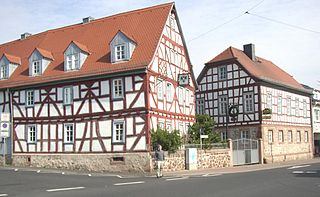
Altenstadt is a municipality in the district Wetteraukreis, in Hesse, Germany. It is situated in the Nidder valley, approx. 27 kilometers north-east of Frankfurt am Main.
Ernst Ludwig Theodor Henke, was a German theologian and historian, and the son of the theologian Heinrich Henke (1752–1809). He was the father of anatomist Wilhelm von Henke (1834–1896).
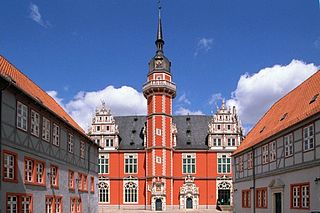
Helmstedt is a town on the eastern edge of the German state of Lower Saxony. It is the capital of the District of Helmstedt. The historic university and Hanseatic city conserves an important monumental heritage of Romanesque and Renaissance buildings, as well as numerous timber framed houses. During the German partition the nearby Bundesautobahn 2 was the site of the Helmstedt–Marienborn border crossing, the most important on the former inner German border as starting point of the shortest land route between West Germany and West Berlin.

Johann Beckmann (1739–1811) was a German scientific author and coiner of the word technology, to mean the science of trades. He was the first man to teach technology and write about it as an academic subject.

Berthelsdorf is a former municipality in the district of Görlitz, in the southeastern part of the Free State of Saxony, Germany. On 1 January 2013, it was incorporated into the town of Herrnhut.
Friedrich Conrad Dietrich Wyneken was a missionary pastor in the United States. He also served for fourteen years as the second president of the Lutheran Church–Missouri Synod, and helped found Concordia Theological Seminary.
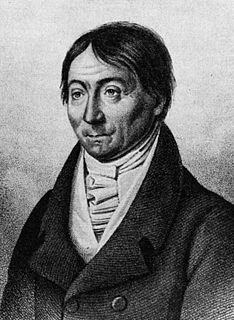
Johann Heinrich Friedrich Link was a German naturalist and botanist. The standard author abbreviation Link is used to indicate this person as the author when citing a botanical name.

The University of Helmstedt, was a university in Helmstedt in the Duchy of Brunswick-Wolfenbüttel that existed from 1576 until 1810.

Caspar Georg Carl Reinwardt was a Prussian-born Dutch botanist. He is considered to be the founding father of Bogor Botanical Garden in Indonesia.
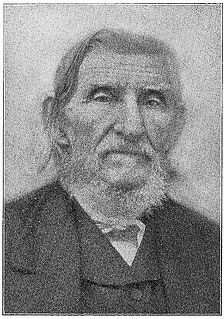
John Christian Frederick Heyer was the first missionary sent abroad by Lutherans in the United States. He founded the Guntur Mission in Andhra Pradesh, India. "Father Heyer" is commemorated as a missionary in the Calendar of Saints of the Lutheran Church on November 7, along with Bartholomaeus Ziegenbalg and Ludwig Ingwer Nommensen.

Christian Gottlob Hammer, baptized as Gottlieb,, was an influential German landscape painter and engraver.

Christian Ignatius Latrobe was an English clergyman of the Moravian Church, as well as an artist, musician and composer. He created a large number of works for, and most famously edited, a Selection of Sacred Music in six volumes between 1806 and 1826, introducing the sacred music of Haydn, Mozart and Pergolesi and other European continental composers who were largely unknown to English audiences.

Frederick II of Hesse-Homburg, also known as the Prince of Homburg was Landgrave of Hesse-Homburg. He was also a successful and experienced general for the crowns of both Sweden and of Brandenburg, but is best remembered as the eponymous hero of Heinrich von Kleist's play Der Prinz von Homburg.

Hendrik Claudius aka Heinrich Claudius was a German painter and apothecary or physician, noted for his 17th-century watercolours of South African plants and animals.
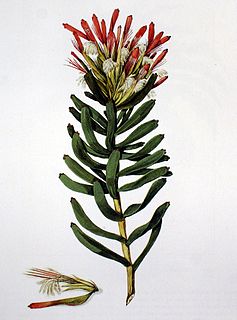
Henrik Bernard Oldenland aka Heinrich Bernhard Oldenland (c.1663–c.1697) was a German-born South African physician, botanist, painter and land surveyor, and is denoted by the author abbreviation Oldenl. when citing a botanical name.

Christian Müller was a Dutch organ builder, born in the Lower Saxony part of Germany. He is renowned for building the great organ in the Grote Kerk, Haarlem, which at the time was deemed as the largest organ in the world; its reputation has been amplified by the fact that several composers have performed on it over the centuries, including Georg Friedrich Handel and Wolfgang Amadeus Mozart.

Johann Benjamin Koppe was a German Lutheran theologian. He originated the "fragment hypothesis" (1783) in response to the Synoptic problem.
Pallas & Poleman were South African pharmacists who played a considerable role in plant collecting in the Cape Colony during the years 1810 to 1839, by employing young German pharmacists such as Bergius, Krebs, Drège and Ecklon.
Caspar is a masculine given name. It may refer to: